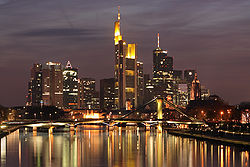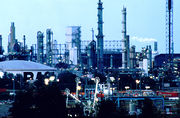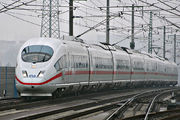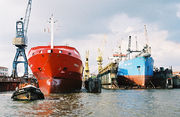Economy of Germany
| Economy of Germany | |
|---|---|
 |
|
| Rank | 4th (nominal) / 5th (PPP) |
| Currency | Euro (EUR)[1] |
| Fiscal year | calendar year |
| Trade organisations | EU, WTO (via EU membership) and OECD |
| Statistics | |
| GDP | $3.673 trillion (2008)[2] |
| GDP growth | -4.9%(2009)[3] |
| GDP per capita | Nominal: $44,729 (2008)[2] |
| GDP by sector | agriculture: 0.9%; industry: 27.1%; services: 72% (2009 est.) |
| Inflation (CPI) | 1.2% (March 2010)[4] |
| Population below poverty line |
11% (2001) |
| Gini index | 27 (2006) |
| Labour force | 43.51 million (2009 est.) |
| Labour force by occupation |
services (67,5%), industry (29,7%), agriculture (2,4%) (2005) |
| Unemployment | 7% (June 2010)[5] |
| Main industries | iron, steel, coal, cement, chemicals, machinery, vehicles, machine tools, electronics, food and beverages, shipbuilding, textiles |
| Ease of Doing Business Rank | 25th[6] |
| External | |
| Exports | $1.121 trillion (2009 est.) |
| Export goods | machinery, vehicles, chemicals, metals and manufactures, foodstuffs, textiles |
| Main export partners | France 10.2%, U.S. 6.7%, Netherlands 6.7%, U.K. 6.6%, Italy 6.3%, Austria 6%, China 4.5%, Switzerland 4.4% (2009 est.) |
| Imports | $931.3 billion (2009 est.) |
| Import goods | machinery, vehicles, chemicals, foodstuffs, textiles, metals |
| Main import partners | Netherlands 8.5%, China 8.2%, France 8.2%, U.S. 5.9%, Italy 5.9%, U.K. 4.9%, Belgium 4.3%, Austria 4.3%, Switzerland 4.2% (2009 est.) |
| FDI stock | $1.021 trillion (31 December 2009 est.) |
| Gross external debt | $5.208 trillion (30 June 2009) |
| Public finances | |
| Public debt | 77.2% of GDP (2009 est.) |
| Revenues | $1.398 trillion (2009 est.) |
| Expenses | $1.54 trillion (2009 est.) |
| Economic aid |
donor: $7.5 billion, 0.28% of GDP GDP Germany is ranked on the CPI [3] 2009 as 14th for the perceived level of public sector corruption, with a confidence range between 7.7-8.3. (2004)[7] |
| Foreign reserves | $138 billion (31 December 2008 est.) |
[https://www.cia.gov/library/publications/the-world-factbook/geos/gm
All values, unless otherwise stated, are in US dollars |
|
Germany is the largest national economy in Europe, the fourth-largest by nominal GDP in the world, and fifth by GDP (PPP) in 2008.[1] Since the age of industrialisation, the country has been a driver, innovator, and beneficiary of an ever more globalised economy. Germany is the world's second largest exporter with $1.170 trillion exported in 2009 (Eurozone countries are included).[2] Exports account for more than one-third of national output.[3]
Germany is relatively poor in raw materials. Only lignite and potash salt are available in economically significant quantities. Power plants burning lignite are one of the main sources of electricity in Germany. Oil, natural gas and other resources are, for the most part, imported from other countries. Germany imports about two thirds of its energy.
The service sector contributes around 70% of the total GDP, industry 29.1%, and agriculture 0.9%. Most of the country's products are in engineering, especially in automobiles, machinery, metals, and chemical goods.[4] Germany is the leading producer of wind turbines and solar power technology in the world. The largest annual international trade fairs and congresses are held in several German cities such as Hanover, Frankfurt, and Berlin.[5]
Of the world's 500 largest stock market listed companies measured by revenue, the Fortune Global 500, 37 are headquartered in Germany. In 2010 the ten largest were Volkswagen, Allianz, E.ON, Daimler, Siemens, Metro, Deutsche Telekom, Munich Re, BASF, and BMW.[6] Other large German companies include: Robert Bosch, Thyssen Krupp, and MAN (diversified industrials); Bayer and Merck (pharmaceuticals); Adidas and Puma (clothing and footwear); Commerzbank and Deutsche Bank (banking and finance); Edeka (retail); SAP (computer software); Infineon (semiconductors); Henkel (household and personal consumer products); Deutsche Post (logistics); and Hugo Boss (luxury goods). Well known global brands are Mercedes Benz, BMW, Adidas, Audi, Porsche, Volkswagen, DHL, T-Mobile, Lufthansa, SAP, and Nivea.[7]
As of September 2008[update], as measured by ILO standards the German unemployment rate was 6.2 percent (compared with 7.4 percent as measured by German standards).[8]
Contents |
History
Nazi Era
The economy of Germany during the Hitler era (1933 – 1945) developed a hothouse prosperity, supported with high government subsidies to those sectors that Hitler favored because they gave Nazi Germany military power and economic autarky, that is, economic independence from the global economy.
Adolf Hitler, believing that "the economy is something of secondary importance",[9] left the details of the economic National Socialist Programme out of Mein Kampf.[10] The Nazis rose to power while unemployment was very high,[11] but achieved full employment later thanks to massive rearmament.[12] Their pre-war economic policies, resembling Keynesianism, were in the beginning the brainchildren of their non-Nazi Minister of Economics, Hjalmar Schacht,[11] who was later made to focus more on war production (cf: Military Keynesianism), and was eventually replaced by a Nazi, Hermann Göring.
The trading policies of the Third Reich aimed at discouraging trade with countries outside the German sphere of influence,[13] while making southern Europe largely dependent on Germany.[14] Eventually, the Nazi party developed strong relationships with big business[15] and abolished trade unions[16] while real wages dropped by a fourth,[12] and employees could not easily change employer.[16] Taxes, though, were still low well into the war.[17] Already before the war, people undesirable to the regime were used as slave labour, and in 1944 they reached one quarter of the workers.[18] Some have argued that the Second World War was a direct effect of the German economic system, which made expansionism necessary for domestic prosperity, indeed, survival; and which made Jingoism necessary for the quelling of class conflicts. [19]
Wirtschaftswunder of the West
Beginning with the replacement of the Reichsmark with the Deutsche Mark as legal tender, a lasting period of low inflation and rapid industrial growth was overseen by the government led by German Chancellor Konrad Adenauer and his minister of economics, Ludwig Erhard, raising West Germany from total wartime devastation to one of the most developed nations in modern Europe.
Contrary to popular belief, the Marshall Plan, which was extended to also include Western Germany after it was realized that the suppression of the Western German economy was holding back the recovery of the rest of Europe,[20] was not the main force behind the Wirtschaftswunder.[21][22] The amount of monetary aid (which was in the form of loans) received by Germany through the Marshall Plan (about $1.65 billion in total) was far overshadowed by the amount the Germans had to pay back as war reparations and by the charges the Allies made on the Germans for the ongoing cost of occupation (about $2.4 billion per year).[21] In 1953 it was decided that Germany was to repay $1.1 billion of the aid it had received. The last repayment was made in June 1971.[22]
Apart from these factors, hard work and long hours at full capacity among the population in the 1950s, 1960s and early 1970s and extra labour supplied by thousands of Gastarbeiter ("guest workers") provided a vital base for the economic upturn.
East Germany

By the early 1950s the Soviet Union had seized reparations in form of agricultural and industrial products and demanded further heavy reparation payments.[23] Lower Silesia, which contained coal mines, and Stettin, a prominent natural port, were lost to Poland.
Exports from West Germany exceeded $323 billion in 1988. In the same year, East Germany exported $30.7 billion of goods; 65% to other communist states.[24] East Germany had zero unemployment.[24]
In 1976 average annual GDP growth was roughly 5.9%.[25]
Post-reunification
The German economy practically stagnated in the beginning of the 2000s. The worst growth figures were achieved in 2002 (+1.4%), in 2003 (+1.0%) and in 2005 (+1.4%).[26] Unemployment was also chronically high.[27] Due to these problems, together with Germany's aging population, the welfare system came under a lot of strain. This led the government to push through a wide-ranging programme of belt-tightening reforms, Agenda 2010, including the labour market reforms known as Hartz I - IV. In the latter part of the first decade of 2000 the world economy experienced high growth, from which Germany as a leading exporter also profited. Some attribute the Hartz reforms to the high German growth and declining unemployment, while others contend that it resulted in a massive decrease in standards of living, and that its effects are limited and temporary.[27] This prediction appeared to have come true with the onset of the late 2000s recession, which hit Germany especially hard.
2008–2009 recession
The nominal GDP of Germany contracted in the second and third quarters of 2008, putting the country in a technical recession following a global and European recession cycle.[28] German industrial output dropped to 3.6% in September vis-a-vis August.[29][30] In January 2009 the German government under Angela Merkel approved a €50 billion ($70 billion) economic stimulus plan to protect several sectors from a downturn and a subsequent rise in unemployment rates.[31]
Germany exited the recession in the second and third quarters of 2009, mostly due to rebounding manufacturing orders and exports - primarily from outside the Euro Zone - and relatively steady consumer demand.[27]
GDP growth in 1992-2009
The following table lists the non-seasonally adjusted GDP growth in 1992-2009.[26]
| 1992 | 1993 | 1994 | 1995 | 1996 | 1997 | 1998 | 1999 | |
|---|---|---|---|---|---|---|---|---|
| GDP | €1646.62 bn | €1694.37 bn | €1780.78 bn | €1848.45 bn | €1878.18 bn | €1915.58 bn | €1965.38 bn | €2012.00 bn |
| Change | +7.3% | +2.9% | +5.1% | +3.8% | +1.5% | +2.1% | +2.6% | +2.4% |
| 2000 | 2001 | 2002 | 2003 | 2004 | 2005 | 2006 | 2007 | 2008 | 2009 | |
|---|---|---|---|---|---|---|---|---|---|---|
| GDP | €2062.50 bn | €2113.16 bn | €2143.18 bn | €2163.80 bn | €2210.90 bn | €2242.20 bn | €2325.10 bn | €2428.20 bn | €2495.80 bn | €2409.10 bn |
| Change | +2.5% | +2.5% | +1.4% | +1.0% | +2.2% | +1.4% | +3.7% | +4.4% | +2.8% | -3.5% |
Economic regions
In several European countries, such as United Kingdom and France, the capital city dominates the national economy. Germany, on the other hand, does not have a single economic center: it is a polycentric country. Only 3 of Germany's 100 largest companies are headquartered in the capital Berlin. For example, the stock exchange is located in Frankfurt am Main, the largest Media company (Bertelsmann AG) is headquartered in Gütersloh; the most important car manufacturers are in Wolfsburg, Stuttgart and München.[32]
Old Bundesländer
One of Germany's strongest (and at the same time oldest) economic regions is the Ruhr area in the west, between Bonn and Dortmund. 27 of the country's 100 largest companies are located there. The region also has one of the highest GDP per capita figures in Germany. In recent years, however, the area, whose economy is based on natural resources and heavy industry, has seen a substantial rise in unemployment. The economy of Bayern, the state with the lowest number of unemployed people, on the other hand, is based on high-value products. Important sectors are electronics, aerospace and biomedicine, among others. The reason for the low unemployment is that Bayern started its economic rise later, after the Second World War, and does not have as many traditional industries, which are presently encountering problems due to competition from countries such as China and India, as well as the exhaustion of natural resources.[33]
New Bundesländer
With unification on October 3, 1990, Germany began the major task of reconciling the economic systems of the two former republics. Its task was complicated by the dismantling of the extensive welfare system of the former German Democratic Republic, which resulted in a temporary but significant drop of the standard of living of its citizens; interventionist economic planning ensured a quick return of the standard of living and a gradual increase up to the level of that of western Germany. Since reunification, hundreds of thousands of former East Germans have migrated into western Germany to find work. Drastic changes in the socioeconomic landscape brought about by reunification have resulted in troubling social problems. Economic uncertainty in eastern Germany is often cited as one factor contributing to extremist violence, primarily from the political right. Confusion about the causes of the current hardships and a need to place blame have found expression in harassment and violence by some Germans directed toward foreigners, particularly non-Europeans.
Even after the German reunification in 1990, the standard of living and annual income remains significantly higher in the former West German states.[34] The modernisation and integration of the eastern German economy continues to be a long-term process scheduled to last until the year 2019, with annual transfers from west to east amounting to roughly $80 billion. The overall unemployment rate has consistently fallen since 2005 and reached a 15-year low in June 2008 with 7.5%.[35] The percentage ranges from 6.2% in former West Germany to 12.7% in former East Germany.
Natural resources
The German soil is relatively poor in raw materials. Only lignite (brown coal) and potash salt (Kalisalz) are available in significant quantities. Oil, natural gas and other resources are, for the most part, imported from other countries.[36]
The potash salt deposits are a result of the drying up of the Zechstein sea, which 250 million years ago covered large parts of North and Central Europe. Potash salt is mined in the center of the country (Niedersachsen, Sachsen-Anhalt and Thüringen). The most important producer is K+S AG (formerly Kali und Salz AG).[37]
Germany's bituminous coal deposits were created more than 300 million years ago from swamps which extended from the present-day South England, over the Ruhr area to Poland. Lignite deposits developed in a similar way, but during a later period, about 65 million years ago. Due to the fact that the wood is not yet completely transformed into coal, brown coal contains less energy than bituminous coal.[38]
Lignite is extracted in the extreme western and eastern pars of the country, mainly in Nordrhein-Westfalen, Sachsen and Brandenburg. Considerable amounts are burned in coal plants near to the mining areas, to produce electricity. Transporting lignite over far distances is not economically feasible, therefore the plants are located practically next to the extraction sites. Bituminous coal is mined in Nordrhein-Westfalen and Saarland. Most power plants burning bituminous coal operate on imported material, therefore the plants are located not only near to the mining sites, but throughout the country.[39]
Sectors
Primary
In 2008 agriculture, forestry, and mining accounted for only 0.9% of Germany’s gross domestic product (GDP) and employed only 2.4% of the population,[4] down from 4% in 1991. Much of the reduction in employment occurred in the eastern states, where the number of agricultural workers declined by as much as 75% following reunification. However, agriculture is extremely productive, and Germany is able to cover 90% of its nutritional needs with domestic production. In fact, Germany is the third largest agricultural producer in the European Union after France and Italy. Germany’s principal agricultural products are potatoes, wheat, barley, sugar beets, fruit, and cabbages. Despite Germany’s high level of industrialization, almost one-third of its territory is covered by forest.[40] The forestry industry provides for about two-thirds of domestic consumption of wood and wood products, so Germany is a net importer of these items.
Industry

Industry and construction accounted for 29% of gross domestic product in 2008, and employed 29.7% of the workforce.[4] Germany excels in the production of automobiles, machine tools, and chemicals. With the manufacture of 5.5 million vehicles in 2003, Germany was the world’s third largest producer of automobiles after the United States and Japan, although the People's Republic of China was threatening to displace Germany in the world rankings as early as 2005. In 2004 Germany enjoyed the largest world market share in machine tools (19.3%). Of vital importance is the role of small- to medium-sized manufacturing firms, which specialize in niche products and often are owned by management.[41]
Tertiary sector
In 2008 services constituted 69% of gross domestic product (GDP), and the sector employed 67.5% of the workforce.[4] The subcomponents of services are financial, renting, and business activities (30.5%); trade, hotels and restaurants, and transport (18%); and other service activities (21.7%).
Energy
Germany is the world's fifth largest consumer of energy, and two-thirds of its primary energy was imported in 2002. In the same year, Germany was Europe's largest consumer of electricity, totaling 512.9 terawatt-hours. Government policy promotes energy conservation and the development of renewable energy sources, such as solar, wind, biomass, hydroelectric, and geothermal energy. As a result of energy-saving measures, energy efficiency has been improving since the beginning of the 1970s. The government has set the goal of meeting half the country's energy demands from renewable sources by 2050.
In 2000, the government and the German nuclear power industry agreed to phase out all nuclear power plants by 2021.[42] The government reversed this decision in January 2010, electing to keep plants open. Renewable energy still plays a more modest role in energy consumption.
In 2009, Germany consumed energy from the following sources:[43]
- Oil 34.6%
- Natural gas 21.7%
- Lignite 11.4%
- Bituminous coal 11.1%
- Nuclear power 11.0%
- Hydro and wind power 1.5%
- Others 9.0%
Renewable energy is far more present in the domestically produced energy, since Germany imports about two thirds of its energy.
Oil and gas transport
There are 3 major entry points for oil pipelines: in the northeast (the Druzhba pipeline, coming from Gdańsk), west (coming from Rotterdam) and southeast (coming from Nelahozeves). The oil pipelines of Germany do not constitute a proper network, and sometimes only connect two different locations. Major oil refineries are located in or near the following cities: Schwedt, Spergau, Vohburg, Burghausen, Karlsruhe, Köln, Gelsenkirchen, Lingen, Wilhelmshafen, Hamburg and Heide.[44]
Germany's network of natural gas pipelines, on the other hand, is dense and well-connected. Imported pipeline gas comes mostly from Russia, the Netherlands and the United Kingdom. Although gas imports from Russia have been historically reliable, even during the cold war, recent price disputes between Gazprom and the former Soviet states, such as Ukraine, have also affected Germany. As a result, high political importance is placed on the construction of the Nord Stream pipeline, running from Vyborg in Russia along the Baltic sea to Greifswald in Germany. This direct connection avoids third-party transit countries.[45]
Infrastructure
With its central position in Europe, Germany is an important transportation hub. This is reflected in its dense and modern transportation networks. The extensive motorway (Autobahn) network that ranks worldwide third largest in its total length and features a lack of blanket speed limits on the majority of routes.[46]
Germany has established a polycentric network of high-speed trains. The InterCityExpress or ICE is the most advanced service category of the Deutsche Bahn and serves major German cities as well as destinations in neighbouring countries. The train maximum speed varies between 160 km/h and 300 km/h (100-185mph). Connections are offered at either 30-minute, hourly, or two-hourly intervals.[47]

Problems
Germany's industrial sector is facing considerable problems due to competition from cheap labour countries such as China and India. After 1991, the country has lost about 28% of its manufacturing jobs. The number of industrial employees in Germany is now lower than it was in West Germany alone before the unificiation. Labour costs in Germany are one of the highest in Europe.[48] The disappearance of industrial jobs has created a lower class of unemployed, uneducated people who have little chance of re-entering the job market. The service sector can absorb some of those who lose their jobs, but not all.
Another problem, pointed out by Gabor Steingart, is that the country's investment ratio (investment/GDP) has sunken from 18% in 1970 to 3%, and is now only a third of that of the United States. In Western Europe (including Germany) no new company has made it to the top 100 in the last 20 years - some consider this an problematic issue, while others cite it as an indicator of fair competition and lack of monopolization. This is in stark contrast to the United States, where newly founded high-tech companies have experienced significant increases.[49]
See also
- German model
- Trade unions in Germany
- Taxation in Germany
- Metropolitan regions in Germany
- Deutsche Bundesbank
References
- ↑ Rank Order - GDP (purchasing power parity) CIA Factbook 2005. Retrieved 31 December 2006.
- ↑ German trade surplus hits record, BBC, 8 February 2006, Retrieved 3 January 2007.
- ↑ Library of Congress – Federal Research Division (April 2008). "Country Profile: Germany" (pdf). pp. 10. http://lcweb2.loc.gov/frd/cs/profiles/Germany.pdf. Retrieved 2009-01-11. "Exports are responsible for one-third of total economic output, and at the prevailing dollar–euro exchange rate, no country exports more merchandise."
- ↑ 4.0 4.1 4.2 4.3 CIA. "CIA Factbook". https://www.cia.gov/library/publications/the-world-factbook/geos/gm.html. Retrieved 2009-08-02.
- ↑ Wind Power Federal Ministry of Economics and Technology (Germany) Retrieved 30 November 2006.
- ↑ [2], CNN Money. Retrieved 7 August 2010.
- ↑ The 100 Top Brands 2006, Businessweek. Retrieved 26 November 2007.
- ↑ Bundesagentur für Arbeit Nürnberg. "Monatsbericht Oktober 2008" (in German) (pdf). pp. 15. http://www.pub.arbeitsamt.de/hst/services/statistik/000000/html/start/monat/aktuell.pdf. Retrieved 2008-11-23.
- ↑ Henry A. Turner, "Hitler's Einstellung", 1976, p. 90–91
- ↑ Henry A. Turner, "German Big Business and the Rise of Hitler", Oxford University Press, 1985. p.77
- ↑ 11.0 11.1 "http://econ161.berkeley.edu/TCEH/Slouch_Purge15.html". http://econ161.berkeley.edu/TCEH/Slouch_Purge15.html. Retrieved 2007-08-15.
- ↑ 12.0 12.1 "econ161.berkeley.edu". http://econ161.berkeley.edu/TCEH/Slouch_Purge15.html. Retrieved 2007-08-15.
- ↑ Hans-Joachim Braun, "The German Economy in the Twentieth Century", Routledge, 1990, p. 101
- ↑ Hans-Joachim Braun, "The German Economy in the Twentieth Century", Routledge, 1990, p. 102
- ↑ Arthur Schweitzer, "Big Business in the Third Reich", Bloomington, Indiana University Press, 1964, p. 288
- ↑ 16.0 16.1 Nazis and Soviets
- ↑ Hans-Joachim Braun, "The German Economy in the Twentieth Century", Routledge, 1990, p. 114
- ↑ Michael Thad Allen, "The Business of Genocide", The University of North Carolina Press, 2002. p. 1
- ↑ Kaillis, Aristotle Fascist Ideology, London: Routledge, 2000 pages 6-7
- ↑ "Pas de Pagaille!", July 28, 1947
- ↑ 21.0 21.1 German Economic "Miracle" by David R. Henderson
- ↑ 22.0 22.1 "Marshall Plan 1947-1997 A German View" by Susan Stern at the Wayback Machine (archived July 9, 2006).
- ↑ Norman M. Naimark. The Russians in Germany: A History of the Soviet Zone of Occupation, 1945-1949. Harvard University Press, 1995. ISBN 0-674-78405-7 pp. 167-9
- ↑ 24.0 24.1 Boyes, Roger (2007-08-24). "Germany starts recovery from €2,000bn union". London: Times Online. http://www.timesonline.co.uk/tol/news/world/europe/article2317382.ece. Retrieved 2009-10-12.
- ↑ "Business America. (27 February 1989). German Democratic Republic: long history of sustained economic growth continues; 1989 may be an advantageous year to consider this market - Business Outlook Abroad: Current Reports from the Foreign Service.". http://findarticles.com/p/articles/mi_m1052/is_n4_v110/ai_7373809. Retrieved 2007-10-02.
- ↑ 26.0 26.1 Bruttoinlandsprodukt (Vierteljahres- und Jahresangaben) Statistisches Bundesamt.
- ↑ 27.0 27.1 27.2 [https://www.cia.gov/library/publications/the-world-factbook/geos/gm.html CIA Factbook: Germany
- ↑ Hopkins, Kathryn (14 November 2008). "Germany officially in recession as OECD expects US to lead recovery". London: The Guardian. http://www.guardian.co.uk/world/2008/nov/14/oecd-recession-germany-inflation-deflation. Retrieved 1 May 2010.
- ↑ bloomberg.com, German Economy Enters Worst Recession in 12 Years
- ↑ ap.google.com, German economy falls into recession
- ↑ "Germany agrees on 50-billion-euro stimulus plan". France 24. 6 January 2009. http://www.france24.com/en/20090106-germany-agrees-new-50-billion-euro-stimulus-plan.
- ↑ Gürtler, Detlef: Wirtschaftsatlas Deutschland. Rowohlt Berlin, 2010
- ↑ Gürtler, Detlef: Wirtschaftsatlas Deutschland. Rowohlt Berlin, 2010
- ↑ Berg, S., Winter, S., Wassermann, A. The Price of a Failed Reunification Spiegel Online International. 5 September 2005. Retrieved 28 November 2006.
- ↑ Arbeitslosenzahl unter 3,2 Millionen gesunken(German) Tagesschau, Retrieved 1 July 2008.
- ↑ Gürtler, Detlef: Wirtschaftsatlas Deutschland. Rowohlt Berlin, 2010.
- ↑ Gürtler, Detlef: Wirtschaftsatlas Deutschland. Rowohlt Berlin, 2010.
- ↑ Gürtler, Detlef: Wirtschaftsatlas Deutschland. Rowohlt Berlin, 2010.
- ↑ Gürtler, Detlef: Wirtschaftsatlas Deutschland. Rowohlt Berlin, 2010.
- ↑ 31.7% —or about 11,076,000 hectares— of Germany is forested, mongabay.com, 2005.
- ↑ Venohr, Bernd and Meyer, Klaus E. (2007). "The German Miracle Keeps Running: How Germany's Hidden Champions Stay Ahead in the Global Economy". Working Paper 30. FHW Berlin. http://www.berndvenohr.de/download/veroeffentlichungen/forschung/The_German_Miracle_Keeps_Running.pdf. Retrieved 2009-10-09.
- ↑ Germany split over green energy, BBC, Accessed 13 April 2007
- ↑ Energy Consumption in Germany
- ↑ Detlef, Günter: Wirtschaftsatlas Deutschland. Rowohlt Berlin, 2010. p.42
- ↑ Detlef, Günter: Wirtschaftsatlas Deutschland. Rowohlt Berlin, 2010. p.42
- ↑ "Autobahn-Temporegelung" (in German) (PDF). ADAC. October 2007. http://www.adac.de/images/SP_Tempolimit_V%201%2E0_tcm8-199598.pdf. Retrieved 2008-11-15.
- ↑ Geschäftsbericht 2006 der Deutschen Bahn AG, Deutsche Bahn, Retrieved 19 October 2007.
- ↑ Steingart, Gabor: Weltkrieg um Wohlstand. Wie Macht und Reichtum neu verteilt werden. Piper Verlag, München, 2006. (pp. 204-208)
- ↑ Steingart, Gabor: Weltkrieg um Wohlstand. Wie Macht und Reichtum neu verteilt werden. Piper Verlag, München, 2006. (pp. 226-231)
External links
- OECD's Germany country Web site and OECD Economic Survey of Germany
- Federal Statistical Office Germany
- Archive copy at the Wayback Machine. Germany’s growth performance in the 1990s - Published by the European Commission
|
||||||||||||||
